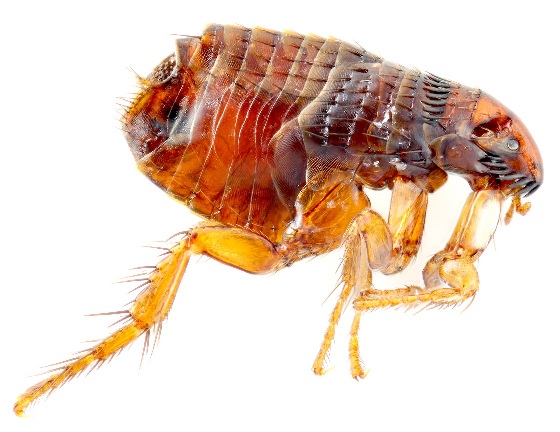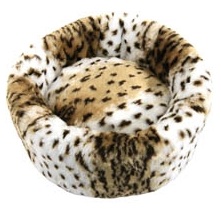Attack Fleas from Every Angle
 We love our pets and most people try to treat them as a member of the family. That can be hard to do when they are responsible for an infestation of fleas. Fleas can be a challenging household problem to overcome; they are tenacious and multiply dramatically. Much like our earlier discussion about mosquitoes, no single product or action will normally be successful. Eliminating the problem requires an integrated and comprehensive approach based on a basic understanding of how the flea life-cycle operates.
We love our pets and most people try to treat them as a member of the family. That can be hard to do when they are responsible for an infestation of fleas. Fleas can be a challenging household problem to overcome; they are tenacious and multiply dramatically. Much like our earlier discussion about mosquitoes, no single product or action will normally be successful. Eliminating the problem requires an integrated and comprehensive approach based on a basic understanding of how the flea life-cycle operates.
Fleas

The type of flea that is commonly found on pets in the United States is the cat flea (Ctenocephalides felis). The cat flea is a small (1-2mm) reddish-black insect that is extremely thin and hard-shelled. They are attracted to the heat given off by host animals and adult fleas attempt to stay on the animal all the time. Although cats are the flea’s preferred host, other animals provide serviceable meals. Humans will be bitten, but do not provide a long term, sustainable environment for fleas. Although fleas by themselves are primarily an irritant, they can spread other parasites and diseases such as varieties of tapeworm and typhus. Additionally, many pets become severely allergic to flea saliva and exhibit dermatitis symptoms. Flea bites are painful and most people are allergic to their saliva to varying degrees, so they produce itchy welts that are similar to ant or mosquito bites. Flea bites are often notable in that they will appear in a line along exposed skin, instead of randomly dispersed. Normally the first indication that your home is infested is the discovery of one or two on the belly of a pet, though the fleas generally prefer to hang around the neck and groin areas, warm and hidden away.
Lifecycle
In order to attack the larger infestation the lifecycle of fleas must be understood. Adult fleas live most of their life on the animal. Stray fleas found around the house have either fallen off or are newly born and seeking a host. Female fleas need a blood meal in order to produce eggs. Adults also produce “flea dust,” which is the dark brown dirt-like remains from these meals. This dust as well as the eggs they lay are not attached to the dog or cat, and fall to the floor. Once the eggs hatch, the various larval stages feed on organic materials, primarily the “flea dust” that has filtered down into the carpet. They will then form a cocoon and pupate within. The adult flea will emerge when it senses the vibration of a host animal and the cycle begins again.
Into the Breach
Due to this complicated life cycle, the flea population in an infested house looks like this: virtually all the adult fleas are on the pet or pets. Virtually all the eggs, larvae and pupae are in the areas where the pet spends most of its time and some are scattered around the household. To solve the problem both of these locations must be addressed simultaneously. The areas where your dog or cat sleep and spend their time must be thoroughly vacuumed to remove as much flea dirt and larvae as possible. This should be repeated periodically. Vacuum bags must be emptied outside the home immediately to prevent re-infestation, unless you use a product specifically designed to kill within the vacuum like Flea Vac pellets. Wash all pet bedding in hot water; steam cleaning has proven effective with bedding and carpets.
 At the same time, you must treat your pet to eliminate the adult fleas. Flea shampoos and dips are somewhat effective, but to disrupt the life cycle an insect growth regulator (IGR) is recommended. IGRs are a family of insecticides that interfere with the fleas’ reproductive system in various ways. Over time these chemicals have proven to be extremely effective with minimal impact on mammals. IGRs can also be used when treating areas frequented by your pets. There are both prescription and non-prescription options for treating your animals. One of the more common methods is the topical application of Frontline, Advantage or Revolution. These are gel products that are applied to a dog or cat’s back or neck that disperses over the body area through normal friction. These are extremely effective if applied correctly and on schedule. It is worth noting that these are serious chemicals being applied to a family member, so consulting a veterinarian is strongly recommended.
At the same time, you must treat your pet to eliminate the adult fleas. Flea shampoos and dips are somewhat effective, but to disrupt the life cycle an insect growth regulator (IGR) is recommended. IGRs are a family of insecticides that interfere with the fleas’ reproductive system in various ways. Over time these chemicals have proven to be extremely effective with minimal impact on mammals. IGRs can also be used when treating areas frequented by your pets. There are both prescription and non-prescription options for treating your animals. One of the more common methods is the topical application of Frontline, Advantage or Revolution. These are gel products that are applied to a dog or cat’s back or neck that disperses over the body area through normal friction. These are extremely effective if applied correctly and on schedule. It is worth noting that these are serious chemicals being applied to a family member, so consulting a veterinarian is strongly recommended.
Fleas are a tremendous irritant and can lead to serious problems for your pet if untreated. Follow these general guidelines and talk to a vet to notably improve you and your pet’s life. For more information, check out the links below:
Texas A&M University “Controlling Fleas”
University of Florida “Fleas What They Are, What to Do?”
University of Nebraska “Integrated Flea Control”





